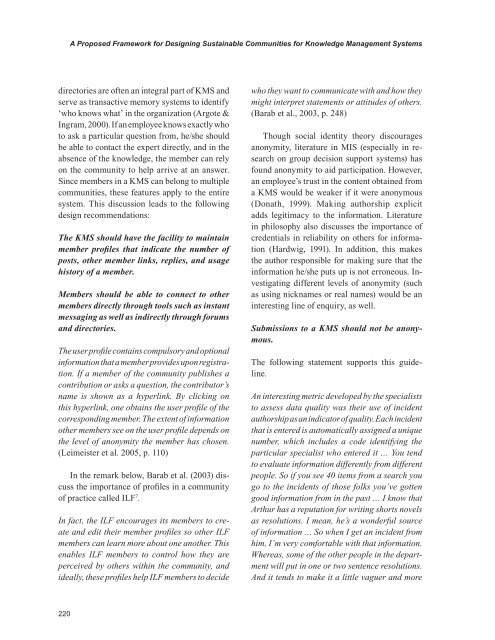Web-based Learning Solutions for Communities of Practice
Web-based Learning Solutions for Communities of Practice
Web-based Learning Solutions for Communities of Practice
Create successful ePaper yourself
Turn your PDF publications into a flip-book with our unique Google optimized e-Paper software.
220<br />
A Proposed Framework <strong>for</strong> Designing Sustainable <strong>Communities</strong> <strong>for</strong> Knowledge Management Systems<br />
directories are <strong>of</strong>ten an integral part <strong>of</strong> KMS and<br />
serve as transactive memory systems to identify<br />
‘who knows what’ in the organization (Argote &<br />
Ingram, 2000). If an employee knows exactly who<br />
to ask a particular question from, he/she should<br />
be able to contact the expert directly, and in the<br />
absence <strong>of</strong> the knowledge, the member can rely<br />
on the community to help arrive at an answer.<br />
Since members in a KMS can belong to multiple<br />
communities, these features apply to the entire<br />
system. This discussion leads to the following<br />
design recommendations:<br />
The KMS should have the facility to maintain<br />
member pr<strong>of</strong>iles that indicate the number <strong>of</strong><br />
posts, other member links, replies, and usage<br />
history <strong>of</strong> a member.<br />
Members should be able to connect to other<br />
members directly through tools such as instant<br />
messaging as well as indirectly through <strong>for</strong>ums<br />
and directories.<br />
The user pr<strong>of</strong>ile contains compulsory and optional<br />
in<strong>for</strong>mation that a member provides upon registration.<br />
If a member <strong>of</strong> the community publishes a<br />
contribution or asks a question, the contributor’s<br />
name is shown as a hyperlink. By clicking on<br />
this hyperlink, one obtains the user pr<strong>of</strong>ile <strong>of</strong> the<br />
corresponding member. The extent <strong>of</strong> in<strong>for</strong>mation<br />
other members see on the user pr<strong>of</strong>ile depends on<br />
the level <strong>of</strong> anonymity the member has chosen.<br />
(Leimeister et al. 2005, p. 110)<br />
In the remark below, Barab et al. (2003) discuss<br />
the importance <strong>of</strong> pr<strong>of</strong>iles in a community<br />
<strong>of</strong> practice called ILF 7 .<br />
In fact, the ILF encourages its members to create<br />
and edit their member pr<strong>of</strong>iles so other ILF<br />
members can learn more about one another. This<br />
enables ILF members to control how they are<br />
perceived by others within the community, and<br />
ideally, these pr<strong>of</strong>iles help ILF members to decide<br />
who they want to communicate with and how they<br />
might interpret statements or attitudes <strong>of</strong> others.<br />
(Barab et al., 2003, p. 248)<br />
Though social identity theory discourages<br />
anonymity, literature in MIS (especially in research<br />
on group decision support systems) has<br />
found anonymity to aid participation. However,<br />
an employee’s trust in the content obtained from<br />
a KMS would be weaker if it were anonymous<br />
(Donath, 1999). Making authorship explicit<br />
adds legitimacy to the in<strong>for</strong>mation. Literature<br />
in philosophy also discusses the importance <strong>of</strong><br />
credentials in reliability on others <strong>for</strong> in<strong>for</strong>mation<br />
(Hardwig, 1991). In addition, this makes<br />
the author responsible <strong>for</strong> making sure that the<br />
in<strong>for</strong>mation he/she puts up is not erroneous. Investigating<br />
different levels <strong>of</strong> anonymity (such<br />
as using nicknames or real names) would be an<br />
interesting line <strong>of</strong> enquiry, as well.<br />
Submissions to a KMS should not be anonymous.<br />
The following statement supports this guideline.<br />
An interesting metric developed by the specialists<br />
to assess data quality was their use <strong>of</strong> incident<br />
authorship as an indicator <strong>of</strong> quality. Each incident<br />
that is entered is automatically assigned a unique<br />
number, which includes a code identifying the<br />
particular specialist who entered it … You tend<br />
to evaluate in<strong>for</strong>mation differently from different<br />
people. So if you see 40 items from a search you<br />
go to the incidents <strong>of</strong> those folks you’ve gotten<br />
good in<strong>for</strong>mation from in the past … I know that<br />
Arthur has a reputation <strong>for</strong> writing shorts novels<br />
as resolutions. I mean, he’s a wonderful source<br />
<strong>of</strong> in<strong>for</strong>mation … So when I get an incident from<br />
him, I’m very com<strong>for</strong>table with that in<strong>for</strong>mation.<br />
Whereas, some <strong>of</strong> the other people in the department<br />
will put in one or two sentence resolutions.<br />
And it tends to make it a little vaguer and more



